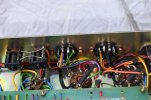maico996
Well-Known Member
- Joined
- Aug 5, 2022
- Messages
- 221
- Reaction score
- 550
If you're looking for a 2204, you could also consider a combo. I have an '82 4010 1x12 which is basically a 2204 in a box. I chopped it into a head a long time ago. It came stock with GE 6550s. Quite a while ago I switched to KT88s. My plate voltage reads right around 386. A very long time ago the voltage switch was removed because a mic stand fell over in our truck and broke the switch. The only other "mod" was piggybacking a resistor on the bias circuit so I could increase the adjustment range for the KT88s. I can post gut shots if needed.
Last edited:









